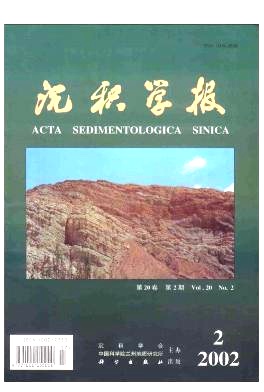HTML
| [1] | 1. Steven A,Hovan,David K Rea,Nicklas G Pisias,et al.A direct link between the China loess and marine δ18O records: Aeolian flux to the north Pacific[J].Nature,1989,340: 296~300 2. 杨达源。中国东部的第四纪风尘堆积与季风变迁[J].第四纪研究,1991,4: 354~358 [Yang D Y.Monsoon evolution and Quaternary aeolian sediment in the eastern part of China [J].Quaternary Science,1991,4: 354~358 ] 3. 刘东生等。黄土与环境[M].北京:科学出版社,1985.191~208 [Liu T S.et al.Loess and Environment[M].Beijing: Science Press,1985.191~208 (in Chinese)] 4. 安芷生,Porter S,Chappell J等。最近130ka洛川黄土堆积序列与格棱兰冰心记录[J].科学通报,1994,39: 2 254~2 256 [An Z S,Porter S,Chappell J,et al.Ice core record in the Greenland and the sediment sequence of Luochuan loess during the recent 130 ka [J].Chinese Science Bulletin,1994,39: 2 254~2 256] 5. 丁仲礼,刘东生,刘秀铭等。250万年以来的37个气候旋回[J].科学通报,1994,39:1 494~1 496 [Ding Z L,Liu T S,Liu X M,et al.37 climatic sequences since 2,500,000 yrs [J].Chinese Science Bulletin,1994,39: 1 494~1 496 ] 6. 黄姜侬,方家骅,邵家骥等。南京下蜀黄土沉积时代的研究[J].地质论评,1988,34: 240~247 [Huang J N,Fang J H,Shao J J,et al.Study on the sediment age of the Xiashu Loess of the Nanjing [J].Geological Review,1988,34: 240~247 ] 7. 徐馨。宁镇地区第四纪古环境[J].南京大学学报,1987,8: 21~31 [Xu X.Quaternary paleoenvironment in the Ningzhen region [J].Journal of Nanjing University,1987,8: 21~31] 8. 张建军,杨达源,陈曰友等。长江中下游地区下蜀黄土磁化率曲线与环境变迁[J].沉积学报,2000,18: 18~21 [Zhang J J,Yang D Y,Chen Y Y,et al.Magnetic curves of the Xiashu loess and the environment evolution in the middle and the lower reaches of the Yangtse River [J].Acta Sedimentologica Sinica,2000,18: 18~21] 9. 徐馨,何才华,沈志达等编著。第四纪环境研究方法[M].贵阳:贵州科技出版社,1992.89~104 [Xu X,He C H,Shen Z D.Method of Study on the Quaternary environment[M].Guiyang: Science and Technology Press of Guizhou,1992.89~104] 10. 孙东怀,鹿化煜,David Rea 等。中国黄土粒度的双峰分布及其古气候意义[J].沉积学报,2000,18(2): 327~335 [Sun D H,Lu H Y,David R,et al.Double-peak grain-size distribution of the loess in China and its paleoclimatic meaning [J].Acta Sedimentologica Sinica,2000,18(2): 327~335] 11. 鹿化煜,安芷生。黄土高原黄土粒度组成的古气候意义[J].中国科学(D辑),1998,3: 278~283 [Lu H Y,An Z S.Paleoenvironment meaning in the grain size component in the Loess Plateau [J].Science in China (Series D),1998,3: 278~283] 12. Xiao J L,An Z S,Liu T S,et al.East Asian monsoon variation during the last 130ka: evidence from the loess plateau of Central China and Lake Biwa of Japan[J].Quaternary Science Reviews,1999,18: 147~157 13. 辽宁省地质局水文地质大队。辽宁第四纪[M].北京:地质出版社,1983.46~85 [Geology Group of Hydrology Geology in Liaoning Province.Quaternary Geology in Liaoning[M].Beijing:Geology Publishing House,1983.46~85] 14. 郑祥民,严钦尚,郭蓄民。长江三角洲南部晚更世晚期风成黄土与地层[A].长江三角洲现代沉积研究[C].上海:华东师范大学出版社,1987.76~91 [Zheng X M,Yan Q S,Guo X M.Aeolian loess and stratigraphy of mid-Pleistocene in the south of the Yangtse Delta,Study on the present sediment of the Yangtze Delta [M].Shanghai:East-China Normal University Press,1987.76~91] 15. 李徐生,杨达源,鹿化煜等。皖南第四纪风尘堆积序列粒度特征及其意义[J].海洋地质与第四纪地质,1997,17: 73~81 [Li X S,Yang D Y,Lu H Y,et al.Grain-size characteristics of the Quaternary Aeolian sequence in south Anhui province and its climate meaning [J].Marine Geology and Quaternary Geology,1997,17: 73~81] 16. Oldfield F.Evironmental magnetism-Personal perspective[J].Quaternary Science Reviews,1991,10: 73~83 17. Thompson R,Oldfield F.Environmental magnetism[M].London: Goerge Allen & Uniwin,1986 18. Maher B A,Thompson R.Mineral magnetic record of the Chinese loess and palaeosol[J].Geology,1991,19: 3~6 19. Heller F,Liu T.Palaeoclimate and sedimentary history from magnetic susceptibility of loess in China[J].Geophysics Research Letters,1986,13: 1169~1172 20. 李峰宇。下蜀黄土的岩石磁学特征[J].南京师范大学学报,1993,16: 44~50 [Li F Y.Magnetism of the Xiashu Loess [J].Journal of Nanjing Normal University,1993,16: 44~50] 21. Derbyshire E,Keen D H,Kemp R A,et al.Loess-Palaeosol sequence as records of palaeoclimatic variations during the last glacial-interglacial cycle: someproblems of correlation in north-central China[A].In: Derbyshire E,ed.Wind blown sediments in the Quaternary record,Quaternary Proceedings[C].Chichester,UK: Wiley,1995a,4:7~18 22. 刘秀铭,刘东生,F Heller.黄土频率磁化率与古气候冷暖变换[J].第四纪研究,1990,1: 42~49 [Liu X M,Liu T S.Heller F.Palaeoclimatic changes and the frequency-dependent magnetic susceptibility of loess [J].Quaternary Science,1990,1: 42~49] 23. Huayu Lu,Xiaodong Liu,Fuqing Zhang,et al.Astronomical calibration of loess-paleosol deposits at luochuan central Chinese Loess Plateau[J].Palaeogeography,Palaeoclimatology,Palaeoecology,1999,154: 237~246 24. 汪永进,Hai Cheng,陆从伦。南京汤山猿人洞穴碳酸盐沉积物的电离质谱铀系年代[J].科学通报,1999,44: 1 548~1 551 [Wang Y J,Hai C,Lu C L.TIMS dating of carbonate sediment from the Tangshan pithecanthrope cave,Nanjing,China [J].Chinese Science Bulletin,1999,44: 1 548~1 551] 25. 尤玉柱,于汇历。东北地区史前人类的生存环境[J].第四纪研究,1989,8: 142~159 [You Y Z,Yu H L.Prehistoric human living condition in the north-east of China[J].China Quaternary Science,1989,8:142~159] 26. 朱诚,张建新,俞锦标。南京汤山猿人生存环境重建探讨[J].地理科学,1998,18: 433~441 [Zhu C,Zhang J X,Yu J B.Palaeoenvironmental reconstruction during the period of Nanjing ape man[J].Scientia Geographia Sinica,1998,18: 433~441] |






 DownLoad:
DownLoad: